Home | City Notes | Restaurant Guide | Galleries | Site Map | Search | Contact
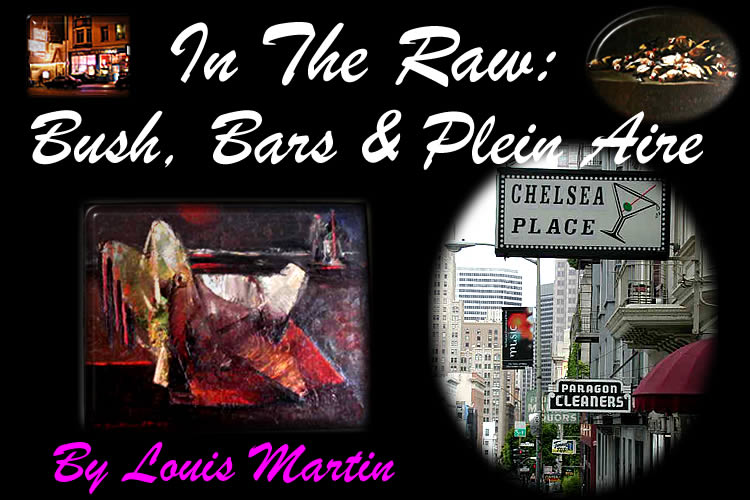
She who was lost has been found, and I am happy—Chan me kwam sook.
"Sa buy dee mai, Fornthipa Xongyingsakthaworn?" (How are you, Fornthipa Xongyingsakthaworn?)
She is "Fong," now calling herself "Fawn" and working at Chelsea Place on Bush Street. What a transformation of names. "Fornthipa Xongyingsakthaworn" to "Fong" to "Fawn." If I did the same thing, I would be down to lower-case letter l.
She is my other daughter, somewhat prodigal, though I have not ordered the slaughter of the fatted lamb just yet. Instead I buy her drinks.
She is innocent as a child,
gentle as a lamb, and comes from Thailand. Her parents brought her
here because business in the United States is better than business
in 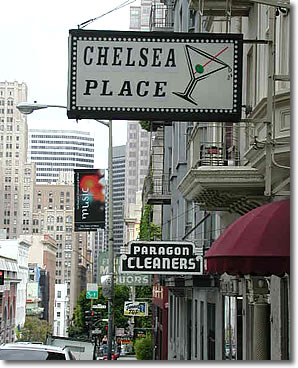 Thailand. But "Thailand better" she told me when I first met her a year
or so ago working at 441 Club down in the Tenderloin. After she described
her house and friends and growing up in Thailand I was baffled why she
was here. As I said, it has to do with business. A lot of people are here
"on business." The money is good, but truth to tell, we don't
like the country that much—or some of our "leaders," anyway.
Thailand. But "Thailand better" she told me when I first met her a year
or so ago working at 441 Club down in the Tenderloin. After she described
her house and friends and growing up in Thailand I was baffled why she
was here. As I said, it has to do with business. A lot of people are here
"on business." The money is good, but truth to tell, we don't
like the country that much—or some of our "leaders," anyway.
But I think Fong has now adjusted to the U.S. since I last saw her. She doesn't talk about Thailand so much anymore, and she is no longer trying to teach me Thai. Before she was drilling me like a school teacher. "No, all wrong, Louis. Say like this ... No one understand you."
She's innocent and gentle, as I said. She really is. But it is not exactly the innocence and gentleness that you may know. It is not an "American" innocence. She drinks and she smokes and she is vain about her image. I know: I have been trying to shoot the perfect picture of Fong for some time now. She is very photogenic; she is a kind of Asian Snow White. But the perfect shot always eludes me. It escapes into the bush like a spooked rabbit. When the camera comes out she poses; when it is tucked away, she is her beautiful natural self.
The other day when I suggested a side shot she said to me, "I have thousand photographs of me at home. I never look good from side." Also, she had a little confession to make: She likes "stuff." Meaning clothes and jewelry.
Sounds more like some vain bitch? Maybe. So how do you put this together with "innocent and gentle"? For one thing, she does not wear the fancy stuff. She just likes having it. Or if she does wear a beautiful blouse or fancy sweater, it is with a pair of old jeans. But I'm not going to try to reconcile this. I think it is just part of the female psyche. It is beyond explanation and words. I will leave explanations to Dr. Freud. I only tell you the way things are.
Chelsea Place is a few blocks out of the Tenderloin. At 441 Club she was a jewel among many cheap beads. She has moved up in the world. Know Chelsea Place on Bush Street? Know Bush Street for that matter? Both take time to get to know. You have to experience them to know them; you have to feel them up a little, goose them. A quick walk down Bush street into the financial district tells you nothing. It will look like any other street with a lot of old apartments that could use some fixing up.
It looks nheuy, or tired. "No, you say that wrong way," says Fong. "That way sound like you throw up."
"Quiet," I tell her, "shhhhhhhh!" I say in that universal language, onomatopoeia.
She looks at me with mock hurt, then is quiet as a child. Which is the real Fong? Both.
I ask her about her "really good boyfriend." That is part of the reason she is here too.
"What really good boy friend?" she asks. "How long ago I tell you that?"
"Three weeks ago," I say. I feel like friar Lawrence chiding Romeo for his heart's short attention span.
But back to Bush. Bush is midway
between Nob Hill and the Tenderloin and it is not really part of either.
Sometimes it has put on airs and thought of itself as Nob Hill or Lower
Nob Hill but no one has ever really bought that. You smile and change
the subject when someone floats such a peculiar notion. It's a bit of
the Emperor Norton personality coming out in that person; it will pass.
The best thing to do is say
to yourself "Bush is Bush" a few times and then try to discover
what is actually there. With bars you will find a certain uniformity.
There are no high-class bars on Bush. Not, at least, till you get downtown.
Up the street from Chelsea Place is Yong San Lounge. Yong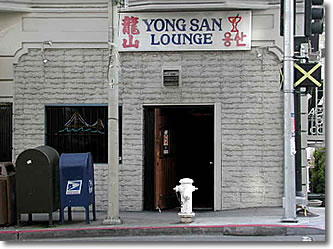 San Lounge is architecturally strange. It is built of cement blocks. It
is like something you would see out in the desert.
San Lounge is architecturally strange. It is built of cement blocks. It
is like something you would see out in the desert.
It is solid; nothing is going to knock it down. But it is most un-San Francisco in that it is totally inelegant. My guess is this: it is a low-cost replacement for something that burned down. Rather than leave the lot vacant, the owner, who was probably strapped for cash at the time, decided on something that was cheap and could not ever burn down again. A solid choice in a way but totally out of character with San Francisco thinking where risk and elegance make a think beautiful and valued. But this is Bush. Go inside Yong San and you will see that it looks like restrooms and storage space was an afterthought. The owner of the building, having opened a bar there, discovered that guys do not go home to take a pee. So a contractor was called in to make restrooms. He did his best on a low budget.
One other thing you will notice about Yong San is that it is always Christmas there. In other places Christmas light are taken down when Christmas is over. Not so at Yong San. There the lights went up one year and stayed up. That is kind of nice, actually.
The other nice thing is the bartenders: Asian and friendly. They will ask your day off even if they don't have anything particular in mind. They are calculating how your schedule might work with theirs. Pays to be practical, I suppose.
Now I have a friend who popped into Yong San the other day and said all the bartenders looked like prostitutes. Well I don't buy that. Maybe they look a little whorish, but look at the women who work in the offices downtown. Now that is whorish. They make the girls at Yong San seem like Heidi and her sisters.
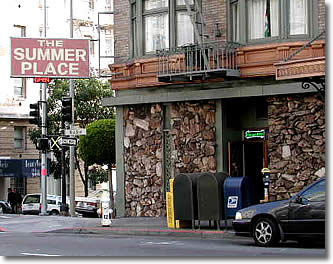 There
are other bars on Bush. There is The Summer Place; there is Bacchus Kirk.
Bacchus Kirk is a kind of second home for some on Bush Street; some customers
leave only to go home, get a shower, and perhaps take a short nap. Both
bars deserve careful study but I have only so much time; there is more
to my life than just bars ... Nevertheless I did drop by The Summer Place
the other day when it was just opening. There were no other customers.
The bartender, an older Vietnamese women, had the doors wide open when
I arrived, chilling the place with lots of cool San Francisco air. It
was kind of refreshing. Then she shut the doors and lit a fire in the
fireplace. In a few minutes it was cozy. It was story time in the olde
tavern. We would talk of noble knights and great deeds.
There
are other bars on Bush. There is The Summer Place; there is Bacchus Kirk.
Bacchus Kirk is a kind of second home for some on Bush Street; some customers
leave only to go home, get a shower, and perhaps take a short nap. Both
bars deserve careful study but I have only so much time; there is more
to my life than just bars ... Nevertheless I did drop by The Summer Place
the other day when it was just opening. There were no other customers.
The bartender, an older Vietnamese women, had the doors wide open when
I arrived, chilling the place with lots of cool San Francisco air. It
was kind of refreshing. Then she shut the doors and lit a fire in the
fireplace. In a few minutes it was cozy. It was story time in the olde
tavern. We would talk of noble knights and great deeds.
She told me about two guys who came in the other day and ordered drinks.
"The one," she says hesitantly, "says he wants a ..." She struggles to say it, then does "... 'cocksucker.' I tell him, 'you get out of here; we're not that kind of place.'"
"No, no, lady," he says. "It's a drink. I'll tell you how to make."
"I'm sorry," she says, "but we don't make those kind of drinks. We're a decent place."
"Well, then, give me a blow job," he says.
"You get out of here," she tells him. We're ..."
The latter is a drink too. He offers to tell her how to make it. Again, she tell him they don't make "those kind of drinks."
I'm not sure how it ended. I tell her about my Chinese friend, Xiao Fan, ordering "Sex on the Beach" down at Le Central. That is a risque-sounding cocktail if there ever was one. The name is a shocker but the drink itself is not even memorable. All the pleasure, if there is any, comes from saying "Sex on the beach" when you order it. My Chinese friend stumbles over English but she had "Sex on the Beach" down perfectly. I think she had been practicing. Now if I could only get her down to the beach! Turns out the ocean scares her.
Now there is a lot more than bars on Bush Street. In fact there is just about everything in one form of another. If you want restaurants, there are restaurants of every kind. Just across the street from Chelsea Place is the renown Masa's. Go up the street a few blocks and on the other side you have VC's Vietnamese Sandwich shop. At Masa's you will pay $125 a person or more; at VC's you can get a Vietnamese sandwich for $2.95 with about the same nutritional value as poulet d'or avec haricot vert. Or splurge at VC's and get Charbroilded Pork Vermicelli for $5.95. Then there is Jasmin's just down the street, offering both Mexican and Korean fare. Some swear by it.
Some say Uncle Vitto's is the
place for pizza. I'll let you judge Uncle Vitto. But if you're not in
the mood for pizza, right next door is Cafe Mozart, featuring not German
or Austrian cuisine but French accompanied by the music of Mozart. There
are also the French and German consulates, where you could go and complain
about Cafe Mozart; and there is Notre Dame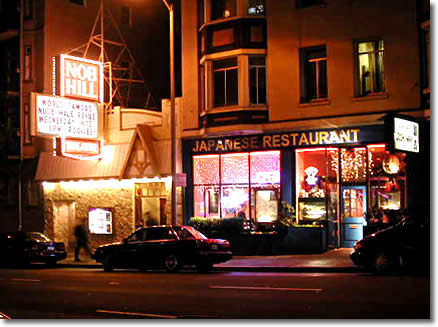 Victoire, where you could ask forgiveness for all of the above. And across
the street and up a bit is the "Nob Hill World Famous All Male Nude
Review." That is right next door to Sushi Man. I'm told there is
no connection. There is Thai food too—BKK—but that is further
up the street past Jones. You don't want to walk that far. You see, there
is much to be found on Bush Street. There is a "Bonded Locksmith"
in a flimsy little shop that also sells liquor and looks like it has not
changed since the old owner died in 1940 and the new owner took over;
there is the elegant White Swan Inn hotel; and if you like dark wood,
sedate pictures, and overstuffed chairs and enjoy the company of guys
sixty and over, there is a private men's club called The Family on the
corner of Powell & Bush. There is also the Moonlight Spa on Bush,
Rainbow Health Club just off Bush in an alley, and The Green Door Ecstasy
Massage, its sign peeping above the overpass at the Stockton tunnel. Bush
is Bush but it is more than a bunch of apartments that could use some
fixing up.
Victoire, where you could ask forgiveness for all of the above. And across
the street and up a bit is the "Nob Hill World Famous All Male Nude
Review." That is right next door to Sushi Man. I'm told there is
no connection. There is Thai food too—BKK—but that is further
up the street past Jones. You don't want to walk that far. You see, there
is much to be found on Bush Street. There is a "Bonded Locksmith"
in a flimsy little shop that also sells liquor and looks like it has not
changed since the old owner died in 1940 and the new owner took over;
there is the elegant White Swan Inn hotel; and if you like dark wood,
sedate pictures, and overstuffed chairs and enjoy the company of guys
sixty and over, there is a private men's club called The Family on the
corner of Powell & Bush. There is also the Moonlight Spa on Bush,
Rainbow Health Club just off Bush in an alley, and The Green Door Ecstasy
Massage, its sign peeping above the overpass at the Stockton tunnel. Bush
is Bush but it is more than a bunch of apartments that could use some
fixing up.
Now one of the places I have always wondered about is a small art gallery that shares a one-story building with a cleaners. The cleaners has the right side, the art gallery the left. It is not like the big pricey art galleries down on Geary and Post. Also, I have never seen the door open or a customer come or go.
The other day I stopped, read the hours (it was open), turned the handle (it turned) and walked inside. I felt like a child walking through some magic door wondering what adventures would follow. The place was stuffed with objects d'art—some pieces on the walls, some on the floor, and some stacked in cases. There was all variety—landscapes, still life, portraits, sculpture ... The classification part of my brain failed to classify. There was no one in the gallery when I entered—yes, there was no high-pressure sales person who jumped me when I walked through the door like downtown. For a few minutes I looked from wall to wall, up and down, back and forth. It was a curious collection. It didn't knock me over, turn me on, or turn me off. It was simply interesting to stare at, pondering where all this stuff came from and who created it and when and where and why and in what state of mind. I found myself in a kind of dream space. I felt like I was eating a Masa's while flat on my back at the Green Door and having a cocktail with some old guy talking about the good old days ... I was strangely content.
Then from the back of the gallery
came a large, gray-bearded man in wool cap and heavy jacket. This was proprietor Chet Helms, who has owned the gallery for
some twenty years. We talk a little about Bush Street. Some years back
he says he held meetings at the gallery for the Nob Hill Terrace Development
Association. The association is now defunct, but I suspect this was back
in days when there was hope for Bush Street to become something that it
did not have the potential to be.
jacket. This was proprietor Chet Helms, who has owned the gallery for
some twenty years. We talk a little about Bush Street. Some years back
he says he held meetings at the gallery for the Nob Hill Terrace Development
Association. The association is now defunct, but I suspect this was back
in days when there was hope for Bush Street to become something that it
did not have the potential to be.
I am used to seeing everything hung in a straight line around a gallery. The downtown galleries have done that to me. Chet explains that that is "wash-line" style of hanging. At Atelier Dore ("Golden Studio"), things are hung European "salon style" where there are various levels. Wash-line style came about, Chet explains, because of a "lot of strife about who got hung where." He says there were even duels fought over hanging height.
Artist: "Mirror, mirror, on the wall, who is the fairest of them all?"
Mirror: "Marc Chagall, you are a very fine artist indeed. But Pablo Picaso is a thousand times better than you!"
Artist: "Ahhhhhhhh!"
Yes, it was that kind of thing. Somehow I had thought artists were better than that, but I suppose I'm naive.
A couple of pieces attract my attention, and I asked Chet about them. There is a scene of a logging operation where logs on a cart are being pulled by oxen. I used to live in logging country and in some of the old barns there were harnesses for oxen that were used in the late 1800s. The painting is by John C. White, a British army officer who was out West on the Union Telegraph Expedition of 1865. He was the official artist for the expedition. If you know the woods, this takes you back in time. It is better than a photograph. It evokes the quietness of the woods, the steadfastness of the logger, at least on the job, and the raw power of the animals pulling the cart. If the woods were being destroyed, at least it was with human will and muscle and not by an army of men with gasoline chain saws and orders from men in high-rise office buildings.
On the left of the logging
scene is another painting. It too transports me but in a different way.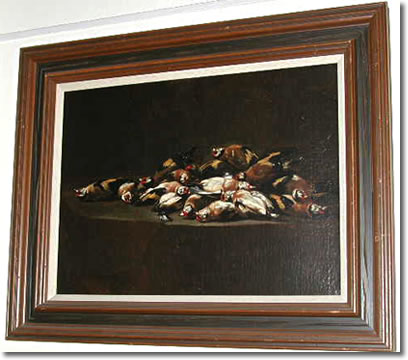 It is a piece by William Hubacek, known as the "Old Master"
by his students. He studied just up the hill at the Mark Hopkins when
it was an art institute and later taught there. He died in 1958 at the
age of 92. The piece I'm looking at is one of those dark still-life types.
In fact, it is very style-life. It is of dead birds laid out on a table.
This is from the days when men went out for a walk in the afternoon with
a shotgun and a bird bag and brought home supper. Ever read Ivan Turgenev?
In "A Sportsman's Sketches" you get a feel for this. Chet calls
the Hubacek's style "old tobacco juice school" combined with
Dusseldorf. The old tobacco juice school uses a narrow range of color;
the Dusseldorf school executes with scientific precision against backgrounds
of dark-earth tones. You may not fall in love with this piece by Hubacek
but it evokes a mood and transports you back to another point in time.
It is like the cocktail with the old guy in the men's club.
It is a piece by William Hubacek, known as the "Old Master"
by his students. He studied just up the hill at the Mark Hopkins when
it was an art institute and later taught there. He died in 1958 at the
age of 92. The piece I'm looking at is one of those dark still-life types.
In fact, it is very style-life. It is of dead birds laid out on a table.
This is from the days when men went out for a walk in the afternoon with
a shotgun and a bird bag and brought home supper. Ever read Ivan Turgenev?
In "A Sportsman's Sketches" you get a feel for this. Chet calls
the Hubacek's style "old tobacco juice school" combined with
Dusseldorf. The old tobacco juice school uses a narrow range of color;
the Dusseldorf school executes with scientific precision against backgrounds
of dark-earth tones. You may not fall in love with this piece by Hubacek
but it evokes a mood and transports you back to another point in time.
It is like the cocktail with the old guy in the men's club.
Chet talks about the plein aire style and the Barbizon school of painters in France. Barbizon is a town in France where Theodore Rosseau and some others abandoned the "academic approach," which involved much laborious copy work. Instead they headed out to the countryside to directly observe their subject matter, which was usually nature itself. Sentiment and allegory were dropped as dead weight. This movement preceded the "ism" of impressionism.
The movement caught on a little later in the United States, as most art movements did back then, but can be seen in a number of works at Atelier Dore. Chet points to a work by Max Weyl as an example. Weyl was a self-taught Washington D.C. artist. It captures the shimmer of light upon a lake seen between trees. It is probably not Weyl's best, but it does capture the moment.
Capturing the moment is not always easy. First you have to find a moment worth capturing. There are many. Then you have to grab it before it is gone. The photographer well knows the problem. The special moments, the truly expressive ones, are always fleeting moments.
Then there is the problem of creating something genuine. That is not easy. There is no formula, no rule to guide you. If the creation is good, then it will probably break the law; someone will hate you for it.
On the opposite wall, hung
low, is an untitled piece by Hans Burkhardt which Chet calls 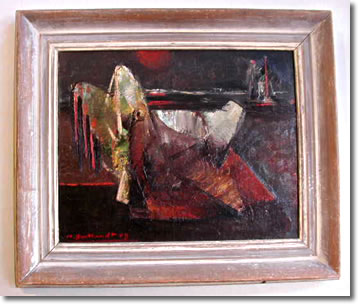 "Marine
Abstraction." It is small, maybe not the best Burkhardt, but captures
my eye. Burkhardt is perhaps the most "modern" painter at Atelier
Dore. His life was a difficult one. He was born in Basil, Switzerland,
and raised in a poor house following his mother's death from tuberculosis.
He describes his early life as "slavery"—all work, no art,
and never enough to eat. When forced to chose a trade, he chose to become
a gardener. He worked for three years as an apprentice, twelve to fourteen
hours per day without pay. Finally he got a break. He wrote his father
in New York, asking if he could come and live with him. His father told
him to come.
"Marine
Abstraction." It is small, maybe not the best Burkhardt, but captures
my eye. Burkhardt is perhaps the most "modern" painter at Atelier
Dore. His life was a difficult one. He was born in Basil, Switzerland,
and raised in a poor house following his mother's death from tuberculosis.
He describes his early life as "slavery"—all work, no art,
and never enough to eat. When forced to chose a trade, he chose to become
a gardener. He worked for three years as an apprentice, twelve to fourteen
hours per day without pay. Finally he got a break. He wrote his father
in New York, asking if he could come and live with him. His father told
him to come.
His father, who was foreman of a furniture factory, got him a job in the decorating department. That led to art school. But then his father was killed in an automobile accident. It is a long story, but he ended up at the Grand Central School of Art where he met Arshile Gorky, a wild and inspiring Turkish Armenian artist who taught there. Meeting Gorky, he says, was the best thing that ever happened to him. But it was the breakdown of his marriage that brought him out to California and a new life. But even then there were obstacles. To get by in his new life, he again took up furniture decoration. In later years he was professor of art at the University of Southern California and UCLA. This is a long way from the hungry kid in a poor house in Switzerland. While his paintings are "abstract," they are never wholly so. He always maintains a human reference point.
One can capture the moment or one can create it out of one's life experience. Burkhardt, I think, does the latter. But in any case, as he says, "something has to happen." Making the "most beautiful, most interesting type of work" is not enough for him. For the experiential artist, the material has to be worked until something brand new emerges. The artist has to experience the world and then go into labor. One can walk in the woods or become the woods; one can wait for a robin's egg to fall from the nest, or one can become the robin's egg.
It is cold in the studio. Chet sits slouched in a chair by the window. His voice is soft and gentle; he takes his time answering questions. He has a show of his own coming up at Artemis Gallery (February 5th to March 21st) on Sutter street. He has been working on a series of photographs of women. A number of pieces are laid out on a shelf under the logging painting by White. They run a range of expression, like everything else in his gallery.
I ask him if he had any trouble getting the women to consent to being photographed. "I didn't have to knock any of them down," he says. This has been my own experience. For the most part, women love to be photographed. It is great fun for them. They may first smile and say no, then they are suggesting better angles and lighting.
His goal is to "capture
something special, some joyful, playful moment." He says he also
enjoys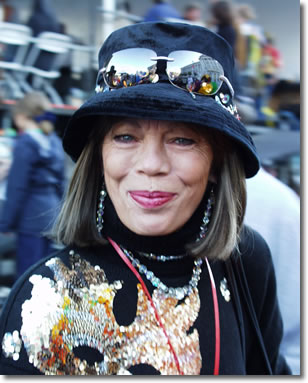 shooting older women. This comes through in several shots. One is of a
women about seventy. She has silver hair and shining eyes. She has more
luster than most of the younger women in his photos. There is a shot of
a younger women dressed in pink. She is a singer. She is full of life
too but I sense some sadness there. She is young and beautiful but in
her expression I sense an awareness that her beauty is only leased. Women
have a problem that men don't, or that is experienced differently by men.
Their beauty fades with age, and young women are treated differently than
older women. (Photo right by Chet Helms.)
shooting older women. This comes through in several shots. One is of a
women about seventy. She has silver hair and shining eyes. She has more
luster than most of the younger women in his photos. There is a shot of
a younger women dressed in pink. She is a singer. She is full of life
too but I sense some sadness there. She is young and beautiful but in
her expression I sense an awareness that her beauty is only leased. Women
have a problem that men don't, or that is experienced differently by men.
Their beauty fades with age, and young women are treated differently than
older women. (Photo right by Chet Helms.)
Fortunately there is another side to this. Chet says he finds women sexy that he would not have found sexy when he was younger. Let's hope it is that way. I'm still excited by the young ones—the Fongs, the Fawns, the Fornthipa Xongyingsakthaworns—with dark hair and fetching smiles whose moods come and go like creatures fleeing into a forest. But who knows? Maybe "something will happen" and I will be healed of desire for these young ones. In the mean time there is Bush Street, bars, and plenty of plein aire.
Home | City Notes | Restaurant Guide | Galleries | Site Map | Search | Contact